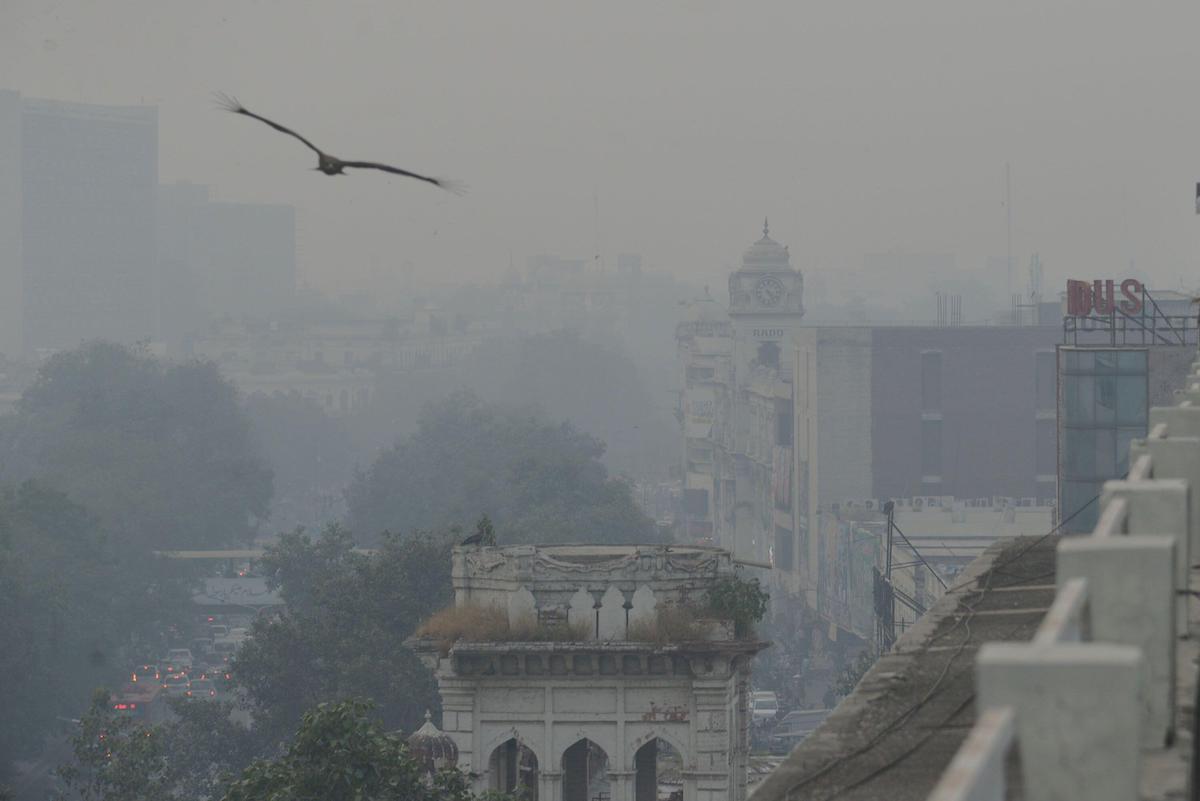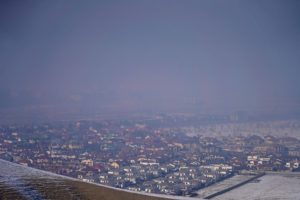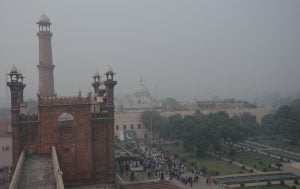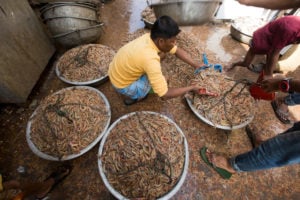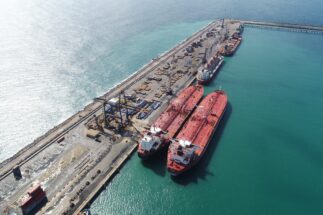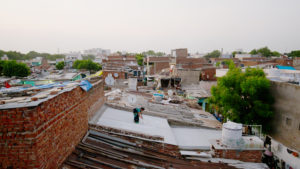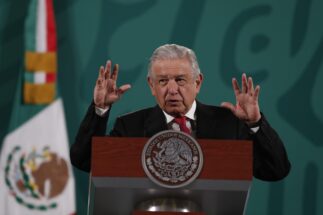As delegates from around the world engage in negotiations at COP26, South Asia is shrouded in a thick pall of air pollution. Few other examples show the distance between global ambitions and local challenges so starkly, with a lack of regional cooperation on environmental issues sabotaging chances of progress.
In New Delhi, the annual additional pollution brought on by fireworks let off on Diwali, the festival of lights, drove the pollution to dangerous heights last week. But while India’s capital garners the most attention, the problem is wider and deeper in scope.
A vast landlocked area from northwest Pakistan through north India all the way to Bangladesh suffers, partly because of geography. For much of the year, warm air rises, taking pollution from the plains with it. But in winter, air cools quickly near the Earth’s surface in low-lying areas surrounded by the higher, colder ranges of the Himalayas. The conditions, called winter inversion, trap cold air near the ground, where it stagnates. As pollutants released by industry, construction and transportation cannot circulate, the air becomes toxic across the region.
Local authorities have reacted spasmodically to the crisis. In the cities of Pakistan, there are attempts to restrict the burning of waste and leaves, and shut down brick kilns. Air quality is unhealthy in all the country’s big cities, particularly in the area between the Jhelum and Sutlej rivers, which includes the cities of Lahore, Multan, Faisalabad, Rawalpindi and Gujranwala.
In India in recent years, the national capital region has adopted a ‘Graded Response Action Plan’, which kicks in when air quality drops below critical thresholds. Kathmandu and New Delhi, along with its satellite cities, have even declared health emergencies in the past few years, shutting schools and institutions, and issuing alerts.
Piecemeal action on South Asia’s toxic air
However, most efforts to control the severe air pollution in South Asia have been piecemeal, with little or no coordinated action. The problem is pervasive, across provincial and national borders in one of the most densely populated regions of the planet, with multiple cities and innumerable human habitations affected.
The extent of the problem overpowers and undermines local action, increasing the vulnerability of the people, experts told The Third Pole.
“Managing air quality to keep it below health thresholds requires detailed understanding of when and how pollutants flow across borders and have impacts across borders, as well as regionally coordinated temporary emissions reductions,” said atmospheric scientist Arnico Panday, formerly of the International Centre for Integrated Mountain Development and advisor to Nepal’s planning commission. “This needs regional modelling, access to data from across the region, and a willingness to cut down domestic emissions in order to reduce the impacts across the border.”
We need a comprehensive regional planAnumita Roychowdhury, Centre for Science and Environment
“The overarching goal of reducing emissions in the region must follow a coordinated approach,” said Dawar Butt, an air quality expert in Pakistan.
Within countries, there are multiple policy dimensions, at the state or provincial level, which – because of their devolved nature – require piecemeal or contextualised interventions, he said. These include industrial estate regulations, thermal power emission standards, petroleum quality standards, vehicle engine specifications, among others.
Initially at least, a “non-binding, trust-based cooperation needs to take place at the multilateral level, which agrees on regional goals, and the federal governments then work towards leading the provinces in designing mid- to long-term action plans, which further implement them,” Butt said.
Satellite images and emerging scientific evidence show pollution builds up across airsheds that span India and South Asia, said Anumita Roychowdhury, executive director at Centre for Science and Environment, a New Delhi-based advocacy group.
An geographical area that shares a common flow of air, which circulates largely within this
India needs a regulatory regional framework for air quality management to control the transboundary and upwind and downwind effects of the regional flow of pollutants across states, Roychowdhury said. “When the entire region is covered in a blanket of smog, not only the big cities but also the small urban centres are affected,” she said. “This shows that massive clean-up is needed across the region.”
Air pollution in South Asia a transboundary problem
The nature of air pollution in South Asia at this time of the year has particular location-specific dimensions. For example, Kathmandu’s air quality is “strongly affected by outside sources, such as farm residue burning, which can cut down visibility to 2-3 km, compared with sparkling-clear mountain views on days when only local sources are present”, Panday said.
A World Bank assessment published in November 2020 identified several critical airsheds with high PM2.5 concentrations in South Asia. These include the west-central Indo-Gangetic plain that extends into Pakistan and the central-east Indo-Gangetic plain that extends into Nepal and Bangladesh.
PM2.5 refers to particulate matter that is less than 2.5 microns, or millionths of metres, wide. This type of pollution is considered the most dangerous because the fineness of the particles means they can easily enter the body and blood. Burning matter creates large amounts of PM2.5.
At the policy level, traditional legal approaches remain confined within the boundaries of state, city, or municipal areas, which are simply not enough, experts said, especially when it comes to the seasonal problem of crop stubble burning in Haryana, Punjab and Uttar Pradesh in India and Punjab province in Pakistan, which adds to the pollution load significantly in October and November.
Butt said part of the problem is self-inflicted. “There is a market for stubble in the Pothohar [north Punjab] plateau region of Pakistan,” he said. “Similarly, the stubble can be used in the cottage industry, as well as biofuel manufacture. If we can assign the right pricing for the value of stubble, it may be enough to pay for its own clearing.”
In India, biochemical interventions in the rural areas of Delhi have restricted the practice of burning, and a market is emerging for compacted stubble as biofuel in Punjab and Haryana. However, a lack of coordination among the affected states has hamstrung the efforts.
The science of airshed management also needs to evolve. It has to “develop further to understand the upwind and downwind movement of air and subsequent effect of pollution in the region,” Roychowdhury said. Only then we can hope to “build a regional framework for air pollution control”.
There is a need to “strengthen regional institutions such as ICIMOD [the International Centre for Integrated Mountain Development] and SAARC [the South Asian Association for Regional Cooperation] and empower them to be the voice of science”, added Panday.
That is easier said than done. What are the real chances of cross-border regional cooperation to tackle the air pollution crisis? Not great, if the experts are to be believed.
Political obstacles
“The South Asia region remains marred with political crises, which impacts everything from cultural to policy cooperation,” said Butt. “Regionally, this means that we are not moving forward as there are no examples to follow. Some policy interventions have been adopted without understanding specific needs and hence have largely been unsuccessful or ineffective.”
Panday is more scathing. The leaders in the region are caught up in political jingoism, he said. “What is needed is for people to rise up and vote for leaders who focus on the main issues that affect long-term wellbeing: climate change and air pollution, rather than playing petty geopolitical games,” Panday said.
“At the international level, intergovernmental treaties and agreements on transboundary air pollution like the Convention on Long-Range Transboundary Air Pollution, are well known,” said Roychowdhury.
Air pollution is no longer only a political issue alone, but also a human rights issueDawar Butt, air quality expert
Even within countries, many different state jurisdictions have the obligation to meet regional air quality requirements in the developed world, she said. “In Europe, the member states work together to control international air pollution under the Convention on Long-Range Transboundary Air Pollution adopted in 1979.”
These are international agreements that are based on non-binding, enabling and flexible mechanisms, she said. South Asian countries can draw lessons for their own efforts.
Given the magnitude of the air pollution crisis in South Asia, the time has come for a framework of regional cooperation and obligations based on mutually agreed action plans, including targets with adequate resource support, Roychowdhury said. “We need a comprehensive regional plan,” she said.
Airshed approach
Policymakers in these countries need to adopt an airshed approach – that much is obvious. “A limited understanding exists among policymakers, especially after years of activism and lobbying by researchers and civil society in these countries,” said Butt. “But air pollution is not considered an important enough agenda item because of the perceived economic impact of emission-control policies, and hence, not worth spending political capital on.”
Any approach that combines technical understanding along with a method to manage the political costs of implementing collaborative reforms is likely to have more success than awareness alone, he said.
“The largest impact is on the Punjab to Delhi belt, which also happens to be one of the most populated areas on the planet,” said Butt. “Therefore, it is no longer only a political issue alone, but also a human rights issue.”
“The growing air pollution and public health crisis certainly builds a case for a strong regional framework for mitigating regional pollution,” said Roychowdhury. “The State of Global Air 2020 [report] shows that South Asia is one of the most adversely impacted regions in the world.”
